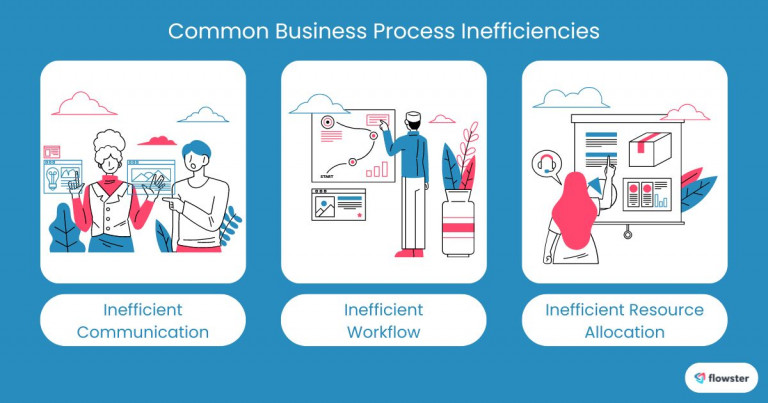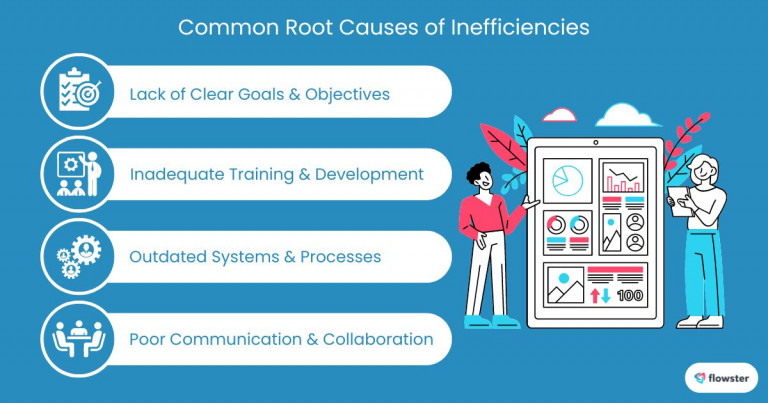In today’s fast-paced business world, efficiency is key to success. Streamlined operations can lead to increased productivity, reduced costs, and improved customer satisfaction. However, identifying and addressing inefficiencies within your business processes can be a daunting task. That’s why we’ve created this comprehensive guide on how to improve business processes. This step-by-step approach will equip you with the tools and knowledge you need to optimize your operations and drive your business forward.
Article Outline
Step 1: Identifying Inefficiencies
The first step in improving your business processes is to identify where inefficiencies exist. By pinpointing these areas, you can begin to develop targeted solutions. Here are some effective techniques to help you identify inefficiencies within your organization.
Brainstorming Techniques
- Observation: Observe your employees’ daily tasks to identify bottlenecks and areas of frustration.
- Interviews: Conduct interviews with employees at all levels to gather their insights on inefficiencies.
- Data analysis: Analyze data such as sales figures, customer feedback, and employee productivity to identify trends and patterns.
Common Areas of Inefficiency
- Communication: Ineffective communication can lead to misunderstandings, delays, and errors.
- Workflow: Inefficient workflows can result in bottlenecks, wasted time, and decreased productivity.
- Resource allocation: Overallocation or underallocation of resources can hinder progress and lead to inefficiencies.
Examples
- Inefficient communication: A lack of clear communication between departments can result in delays and errors in orders.
- Inefficient workflow: A complex approval process can slow down decision-making and reduce efficiency.
- Inefficient resource allocation: Overallocation of resources can lead to burnout and decreased productivity, while underallocation can hinder progress and increase costs.
By identifying inefficiencies in these areas, you can take steps to streamline your operations and improve overall efficiency.
Once you’ve identified areas of inefficiency, it’s important to delve deeper into the underlying causes to develop effective solutions. In the next section, we’ll discuss how to analyze root causes and develop targeted improvement strategies.

Step 2: Analyzing Root Causes
Once you’ve identified inefficiencies within your business processes, it’s crucial to understand the underlying causes. By analyzing root causes, you can develop targeted solutions that address the core issues and prevent future problems.
Why-Why Analysis
Why-why analysis is a powerful tool for uncovering the root causes of problems. This technique involves asking “why” repeatedly to drill down to the underlying reasons for an issue. For example, if a customer complaint is received, you might ask “why was the customer dissatisfied?” and then continue to ask “why” until you reach the root cause.
Common Root Causes
- Lack of clear goals and objectives: Without clear goals, it’s difficult to align efforts and identify inefficiencies.
- Inadequate training and development: Employees may not have the skills or knowledge needed to perform their tasks effectively.
- Outdated systems and processes: Using outdated systems and processes can hinder efficiency and productivity.
- Poor communication and collaboration: Ineffective communication can lead to misunderstandings, delays, and errors.
Case Studies
- Manufacturing company: A manufacturing company used why-why analysis to identify the root cause of excessive downtime in their production line. By analyzing the underlying issues, they were able to implement changes that reduced downtime and increased productivity.
- Healthcare provider: A healthcare provider used root cause analysis to investigate a patient safety incident. By identifying the underlying causes, they were able to implement measures to prevent similar incidents in the future.
By analyzing root causes, you can develop effective solutions that address the core issues and prevent future problems.
Once you’ve identified the root causes of inefficiencies, you can begin to develop strategies for improvement. In the next section, we’ll discuss how to develop and implement effective improvement strategies.

Step 3: Developing Improvement Strategies
Once you’ve identified inefficiencies and analyzed their root causes, it’s time to develop effective improvement strategies. By implementing these strategies, you can streamline your operations, reduce costs, and enhance productivity.
Process Mapping
Process mapping is a valuable tool for visualizing and analyzing existing processes. By creating a visual representation of your processes, you can identify bottlenecks, redundancies, and areas for improvement. There are various types of process mapping techniques, including flowcharts, value stream maps, and swimlane diagrams.
Lean Principles
Lean principles are a set of guiding principles that can help you identify and eliminate waste from your business processes. Some key lean principles include:
- Eliminate waste: Identify and eliminate activities that don’t add value to your customers.
- Create flow: Streamline your processes to create a smooth flow of work.
- Strive for perfection: Continuously seek to improve your processes and eliminate defects.
- Empower employees: Give employees the authority and tools they need to make decisions and improve their work.
Technology Solutions
Technology can play a significant role in streamlining processes and enhancing efficiency. Some potential technology solutions include:
- Automation: Automate repetitive tasks to free up employees’ time and reduce errors.
- Cloud computing: Store and access data from the cloud to improve accessibility and collaboration.
- Business intelligence: Use data analytics to gain insights into your operations and identify areas for improvement.
- Project management software: Use project management software to plan, track, and manage projects effectively.
By combining process mapping, lean principles, and technology solutions, you can develop effective strategies for improving your business processes.
Once you’ve developed improvement strategies, it’s time to implement them and monitor their effectiveness. In the next section, we’ll discuss how to implement changes and ensure successful outcomes.
Flowster's AI-Driven Automation
Step 4: Implementing Changes
Once you’ve developed effective improvement strategies, it’s time to implement them. Successful implementation requires careful planning, communication, and ongoing monitoring.
Change Management
Effective change management is essential for ensuring that improvements are implemented smoothly and accepted by employees. Key elements of change management include:
- Communication: Clearly communicate the reasons for the changes and the benefits they will bring.
- Training: Provide employees with the training and support they need to adapt to the new processes.
- Involvement: Involve employees in the change process to build buy-in and ownership.
Pilot Testing
Pilot testing is a valuable tool for testing new processes and identifying potential issues before full-scale implementation. By conducting a pilot test, you can:
- Identify and address problems: Identify and address potential issues before they impact the entire organization.
- Gather feedback: Gather feedback from employees and stakeholders to refine the new processes.
- Build confidence: Build confidence in the new processes by demonstrating their effectiveness.
Continuous Improvement
Continuous improvement is essential for maintaining and enhancing the benefits of process improvements. This involves:
- Monitoring and evaluation: Regularly monitor and evaluate the effectiveness of the new processes.
- Data analysis: Use data analysis to identify areas for further improvement.
- Learning from mistakes: Learn from mistakes and use them to refine your processes.
By effectively implementing changes and maintaining a culture of continuous improvement, you can drive ongoing efficiency and success within your organization.
By following these steps and maintaining a focus on continuous improvement, you can effectively improve your business processes and achieve your organizational goals. In the conclusion, we’ll summarize the key points of this guide and provide some final thoughts on the importance of process improvement.
Capture Your Processes in Minutes!
Conclusion: A Roadmap to Process Improvement
In this guide, we’ve outlined a step-by-step approach to improving your business processes. By following these steps, you can:
- Identify inefficiencies within your organization.
- Analyze the root causes of these inefficiencies.
- Develop effective improvement strategies.
- Implement changes successfully.
- Maintain a culture of continuous improvement.
Don’t wait to start improving your business processes. By taking action today, you can enhance efficiency, reduce costs, and improve customer satisfaction.
Get Started with Free Business Process Templates
To help you get started on your journey to process improvement, we offer free business process templates and Standard Operating Procedure (SOP) templates from Flowster Marketplace. These templates can provide a solid foundation for your process improvement efforts.
If you need more comprehensive support, Flowster also offers “Done-for-You” services. Our team of experts can help you identify inefficiencies, develop improvement strategies, and implement changes effectively.
Improving your business processes is an ongoing journey. By following the steps outlined in this guide and leveraging the resources available from Flowster, you can achieve significant improvements in your organization’s efficiency and effectiveness.




